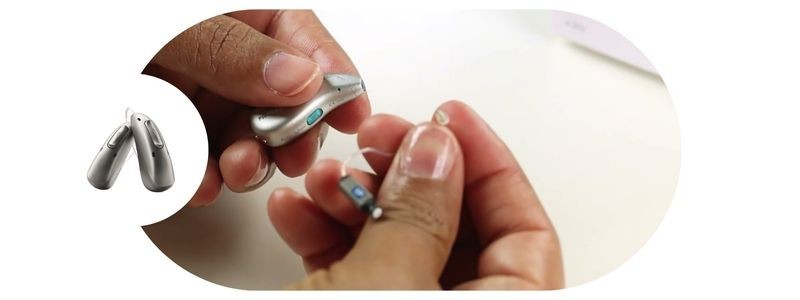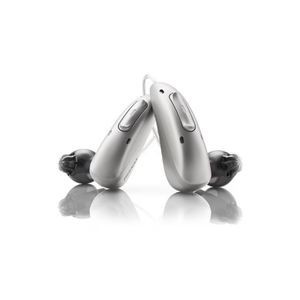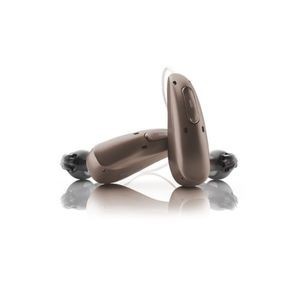Free home visits
with a local audiologist

Last Hearing Aid UK Update:
Discover the latest Phonak hearing aids available in the UK, including top models like the Audeo Infinio, Lumity, and Slim. With advanced features such as universal Bluetooth, AI-powered sound processing, and rechargeable options, Phonak delivers outstanding clarity and comfort.
Whether you're new to hearing aids or looking to upgrade, explore performance levels, designs, and expert comparisons to help you choose the best device for your lifestyle.
►History of Phonak hearing aids
►Key Phonak hearing aid technology
►Chat to us about the best Phonak hearing aids
Who are Phonak hearing aids? Phonak hearing aids, owned by Sonova and the manufacturer Unitron, have led the industry in hearing solutions for over 76 years, offering innovative technologies like universal Bluetooth connectivity and waterproof aids.
Their products, including the Phonak Infinio Ultra, Lumity and Slim ranges, enhance speech understanding and adapt to various environments. Phonak also provides a selection of hearing aid accessories and a user-friendly app for personalised settings and remote care.
Perhaps more interestingly, Sonova also owns the majority shareholding of Boots Hearingcare in the UK. If you've been recommended Phonak hearing aids or Unitron hearing aids by Boots Hearingcare, then it's hardly surprising.
Whether you are looking to upgrade your hearing aids or discovering hearing aids for the first time, we hope this page helps you to understand the Phonak hearing aid brand and the innovations that can really make a difference to your hearing.

You'll find the innovative SmartSpeech technology has a suite of features seamlessly adjusted by AutoSense OS 5.0.
Each of these features has been rigorously tested and proven to enhance either speech comprehension or alleviate the strain of listening across various environments.
SpeechSensor: Continuously monitors all directions to detect where speech is coming from and adjusts microphone directionality accordingly.
If someone addresses you from the side or behind, the hearing aids adapt automatically.
Speech Enhancer: Identifies and boosts soft speech in quiet environments, which is excellent for those frustrating moments when someone's speaking too quietly.

Continuously measures noise levels and applies appropriate reduction to keep speech audible above background sounds whilst preserving speech clarity.
Detects when you're moving versus stationary and adjusts processing to maintain speech understanding whilst managing additional environmental sounds that come with movement.
Whether you're upgrading from older hearing aids or exploring amplification for the first time, Phonak's models offer enough variety that there's likely something that fits both your hearing needs and your lifestyle.
The key is working with a qualified hearing care professional who can help you navigate the options and find the right combination of style and technology level for your particular situation.

AutoSense OS is one of those features that sounds impressive on paper but actually lives up to the hype in practice.
Every 0.4 seconds, which is faster than you can blink, it's analysing your acoustic environment and working out exactly where you are and what you're doing.
Restaurant noise, concert hall acoustics, a quiet chat at home, it knows, and it adapts accordingly.
What makes this genuinely clever is that it doesn't just switch between a handful of preset programmes.
Instead, it blends multiple features together to create over 200 distinct settings, each precisely tailored to your current sound environment.
It's rather like having an experienced sound engineer constantly adjusting the mixing desk based on what's happening around you, except it all happens automatically without you lifting a finger.

Some people have so much hearing loss that it does not help when they turn up the sound to the max. Others must contend with distorted sound when the volume is increased.
This feature enables the hearing aid to collect and reduce the frequency of high-frequency sounds so that they can be heard and understood by the ear.
High-frequency sounds like 's', 'f', and 'th' are crucial for understanding speech but are often the first sounds affected by hearing loss.
SoundRecover2 makes these sounds accessible again without distortion, improving speech clarity significantly.

This is the technology that allows your two hearing aids to actually communicate with each other, which might not sound revolutionary until you realise most hearing aids operate independently.
When you're in a noisy environment or taking a phone call, Binaural VoiceStream shares the audio between both ears so you get proper stereo sound rather than two separate, competing signals.
The practical benefit of this is that speech becomes clearer and more natural because your brain receives the information it needs from both ears simultaneously, just as nature intended.
It's the difference between listening in mono and stereo; once you've experienced it, going back feels oddly flat.

Phonak's Bluetooth connectivity deserves credit for being genuinely straightforward; it works with pretty much any Bluetooth device without requiring special accessories or complicated pairing rituals.
Phone calls, music, podcasts, audiobooks, they all stream directly to both ears with decent quality.
You can even adjust your hearing aid settings through your phone, which is handy when you don't want to fiddle with tiny buttons on the aids themselves.
The hands-free calling is particularly good. You can take calls whilst cooking, driving (with a hands-free kit, naturally), or just wandering about, and the person on the other end comes through clearly in both ears.
It's one of those features that quickly becomes indispensable once you're used to it.

If you've ever struggled with those tiny disposable batteries, and let's be honest, who hasn't dropped one and watched it roll under the sofa, Phonak's rechargeable options will feel like a genuine quality-of-life upgrade.
Pop your hearing aids into their charging case at night, and they'll be fully charged and ready for a full day's use by morning.
No more emergency battery purchases, no more fumbling with fiddly tabs, and no more wondering if you've got spares in your bag.
The charging cases themselves are compact enough to travel with easily, and the battery life is reliable enough that you won't find yourself rationing power halfway through the day.
It's simply one less thing to think about, which in the grand scheme of managing hearing loss is rather welcome.

The Phonak Infinio Ultra Sphere is the world's first hearing aid with a dedicated AI chip designed exclusively for separating speech from noise. This isn't just clever software - it's actual dedicated hardware that delivers three times better speech understanding in noisy environments.
If you've been frustrated by hearing aids that work well at home but struggle in restaurants, social gatherings, or busy workplaces, the Infinio Ultra Sphere addresses this problem with technology that previous hearing aids simply couldn't deliver.
►Phonak Infinio Ultra Sphere i90 hearing aids
►Phonak Infinio Ultra Sphere i70 hearing aids

The Phonak Infinio Ultra R is Phonak's premium model offering thoroughly automated hearing aid technology without the dedicated AI chip of the Sphere range. Using AI-trained sound classification and AutoSense 7.0, these hearing aids recognise your environment and adjust automatically throughout your day - no manual programme switching needed.
For people who want excellent hearing aid performance with reliable Bluetooth connectivity and 31-hour battery life, but don't necessarily need the advanced speech separation technology of the Sphere models, the R delivers impressive results at a more accessible price point.

Choose Ultra R if: You want premium all-around performance with excellent sound quality across varied environments, but don't regularly find yourself in extremely challenging multi-speaker situations. The R offers outstanding value and delivers meaningful improvements over previous generations.
Choose Ultra Sphere if: Speech understanding in noisy, multi-speaker environments is a significant daily challenge. The dedicated AI chip specifically addresses this problem with hardware capabilities that previous hearing aids couldn't achieve.
►Phonak Infinio Ultra i90 R hearing aids
►Phonak Infinio Ultra i70 R hearing aids
►Phonak Infinio Ultra i50 R hearing aids
►Phonak Infinio Ultra i30 R hearing aids

Note: The Audeo Infinio Sphere has been replaced by the Infinio Ultra Sphere, which offers enhanced connectivity and improved battery life. If you're considering the Sphere technology, we recommend the newer Infinio Ultra Sphere range.
The Phonak Audeo Infinio Sphere hearing aids were the first hearing device to house two separate processing chips - one handling your everyday hearing aid functions (the Infinio ERA chip), and a second dedicated entirely to AI-powered sound processing. It's rather like having both a capable generalist and a specialist working together, with the second chip focusing exclusively on the trickiest acoustic challenges.
Sphere technology delivers genuinely impressive performance in background noise, using 4.5 million neural connections to separate speech from noise coming from any direction. Whether it's a packed restaurant or a busy shopping centre, this is the technology tackling exactly the situations where traditional hearing aids tend to struggle most.
►Phonak Audeo Infinio Sphere i90 hearing aids
►Phonak Audeo Infinio Sphere i70 hearing aids

Note: The Audeo Infinio has been replaced by the Infinio Ultra R, which offers enhanced connectivity and improved battery life. If you're considering the Infinio technology, we recommend the newer Infinio Ultra R range.
The Phonak Audeo Infinio hearing aids deliver clear conversations even in challenging listening environments - those situations where background noise and competing voices typically make hearing aids work harder. It's designed to make speech understanding easier whilst reducing the mental effort that often leaves you exhausted after time in noisy places.
►Phonak Audeo Infinio i90 hearing aids
►Phonak Audeo Infinio i70 hearing aids
►Phonak Audeo Infinio i50 hearing aids
►Phonak Audeo Infinio i30 hearing aids

Both the Phonak Infinio Virto Titanium hearing aid model and Virto Infinio hearing aids are custom-designed to fit your ear precisely, suitable for mild to profound hearing loss. The titanium casing is genuinely lighter and more durable than traditional materials, making them comfortable enough that you'll forget you're wearing them.
Powered by Phonak's SmartSpeech Technology and AutoSense OS, they intelligently adapt to different environments automatically without you needing to fiddle with settings.
Features like dedicated noise reduction, speech optimisation, and a specific Music mode handle everything from challenging conversations to your favourite songs. Advanced programs work behind the scenes whilst reliable size 10 disposable batteries keep things simple.
For people wanting custom comfort and performance that simply gets on with helping you hear better, the Virto range delivers without the fuss.
►Phonak Infinio Virto Titanium i90 hearing aids
►Phonak Infinio Virto Titanium i70 hearing aids
►Phonak Infinio Virto i90 hearing aids
►Phonak Infinio Virto i70 hearing aids
►Phonak Infinio Virto i50 hearing aids
►Phonak Ininfio Virto i30 hearing aids

Phonak Slim hearing aids have a unique ergonomic shape that's specifically designed to fit comfortably behind your ear, and crucially, they work properly even if you wear glasses.
This might sound like a small thing until you've tried other hearing aids that constantly get knocked askew by your specs or create uncomfortable pressure points where everything meets behind your ear.
With advanced hearing technology that handles conversations and various listening environments with confidence, the Slim range delivers solid performance wrapped in a design that actually considers how people live.
For those who want hearing aids that blend seamlessly into their daily routine without compromising on comfort or effectiveness, the Slim offers a practical solution that simply works.

Phonak's Audeo Lumity hearing aids are designed to prioritise speech comprehension through their innovative Phonak SmartSpeech Technology, ensuring you can engage comfortably in conversations even in difficult listening environments.
Phonak Lumity hearing aids offer stereo Bluetooth streaming from various devices, pairing with up to 8 and 2 active connections. Tap controls allow managing calls, streaming, and voice assistants. Motion sensing adjusts microphones and noise cancellation. Features like StereoZoom 2.0 and SpeechSensor enhance speech clarity.
The myPhonak app tracks health metrics. Dynamic Noise Cancellation improves listening. The PRISM chip boosts memory and connectivity. Hands-free calling, TV streaming, and lithium-ion rechargeability are included.
At-home adjustments, IP68 moisture protection, RogerDirect streaming, and AutoSense OS 5.0 enhance the user experience.
►Phonak Audeo Lumity L90 hearing aids
►Phonak Audeo Lumity L70 hearing aids
►Phonak Audeo Lumity L50 hearing aids
►Phonak Audeo Lumity L30 hearing aids

The Phonak CROS Infinio hearing aids offer exceptional sound quality, a durable, life-proof design, and a long-lasting rechargeable battery that lasts all day.
Powered by the advanced ERA chip, they provide seamless Bluetooth connectivity with devices like smartphones, tablets, and TVs. Paired with the Phonak Audeo R Infinio, they enhance speech clarity and ensure you're always connected.
►Audeo Infinio CROS hearing aids
Phonak CROS Lumity hearing aids enable conversations to flow seamlessly from every direction. Immerse yourself in every word and live fully with a hearing solution tailored for those facing unaidable hearing loss in one ear.
The Phonak CROS system provides universal connectivity with smartphones, TVs, tablets, and laptops for enhanced accessibility.
►Phonak CROS Lumity hearing aids
Phonak is a top UK hearing aid brand offering advanced features like Bluetooth connectivity, AI sound processing, and rechargeable options. Models such as the Audeo Infinio, Lumity, and Slim suit various hearing needs and lifestyles.
With the myPhonak app and accessories like Roger microphones and TV connectors, users benefit from personalised control and better hearing in complex environments.
Phonak provides a wide range of styles and performance levels to enhance speech clarity and everyday communication.
What sets Phonak apart: Universal Bluetooth connectivity that actually works reliably with both iPhone and Android, proven SmartSpeech Technology backed by clinical research, and AI-trained AutoSense that adapts to your environment without manual intervention. The Infinio Ultra Sphere's dedicated AI chip represents genuine hardware innovation rather than just software refinement.
Can't find the Phonak hearing aid you're looking for? For personalised guidance on selecting the right Phonak hearing aid model for your specific needs, our hearing specialists are available to help.
We're proud to be rated “Excellent” by our customers on Reviews.io – a reflection of the personal service and life-changing results we aim to deliver every day.
Call us free on 0800 567 7621 and one of our experts can help you. Alternatively, you can fill out the quick form at the bottom of the page.
Do not spend hundreds of pounds without getting a second opinion from us.
 Not only are the prices great, but the service is fantastic! Many thanks to your team.
Not only are the prices great, but the service is fantastic! Many thanks to your team.How many years can you expect Phonak hearing aids to endure? The lifespan typically ranges from three to seven years, influenced by factors such as usage, maintenance, storage conditions, and exposure to moisture and heat. It's worth noting that Phonak's lithium-ion rechargeable hearing aids offer a battery life of 24 hours on a single charge.
Phonak hearing aids are Made for Any Phone hearing devices. This means that they are compatible with both iPhone and Android mobiles. However, there are compatibility requirements, so you must check with your audiologist to see if yours can be paired with your Phonak hearing aids.
If your Phonak hearing aids are wireless it means that they have Bluetooth and can be connected to Phonak accessories. However, like most pairings - there are compatibility requirements. Check with your audiologist to see which accessories can be connected to your Phonak hearing aids.
Moisture and condensation have the potential to harm the electronic components within your hearing aid. We advise you to remove the battery from the hearing aid during the night and leave the battery compartment open. Additionally, your hearing care professional can provide specialised drying systems to help safeguard your device.
Replace the dome every three months or if it becomes rigid or fragile. This is to avoid any risk of the dome separating from the receiver sound outlet when inserting or removing it from the ear.
You can adjust the volume on your Phonak devices using the control on the device itself or through the user-friendly Phonak smartphone app by simply sliding the volume bar.
Your hearing aids are programmed by one of our qualified UK audiologists, ensuring they’re ready to wear and match your hearing loss needs.
This service applies to all our models and brands. Need further adjustments? Our aftercare and follow-up appointments are included in the price of the hearing aids. We offer remote support or in-clinic tuning—whichever works best for you.
Phonak, a leader in the hearing aid industry, integrates cutting-edge technology into its devices. Their Roger technology enables seamless connection to Phonak Roger accessories, allowing you to stream high-quality audio from your TV or mobile phone.
Additional features, such as AutoSense OS, can automatically detect sounds from various sources and adjust to your environment. Phonak hearing aids are often praised for their versatility, making them perfect for both urban and rural living, thanks to their adaptability and speech enhancement capabilities.
Most devices connect automatically to the TV Connector, but if yours doesn't, here's what to do:
Position your hearing aids within one meter of the TV Connector and open the battery compartments. Whether you're wearing your hearing aids or they're sitting near the TV Connector, close the battery doors to power them on.
Your hearing aids should automatically pair with the TV Connector once they're powered up. You'll then enjoy clear, synchronised audio streaming directly from your television to your ears.
Battery performance varies based on your usage patterns. Hearing aids with Bluetooth connectivity typically have shorter battery life than standard models since they require additional power to maintain wireless connections with accessories. However, both rechargeable and disposable battery options still offer extensive listening time.
Most rechargeable hearing aids provide all-day power from one overnight charge, making them ideal for active lifestyles and long days away from home.
When we refer to a product as 'Latest Launch', we mean it is the latest to be released on the market.
When we refer to a product as 'New', we mean that the product is the newest hearing aid model on the market.
When we refer to a product as 'Superseded', we mean that there is a newer range available which replaces and improves on this product.
When we refer to a product as an 'Older Model', we mean that it is has been superseded by at least two more recent hearing aid ranges.